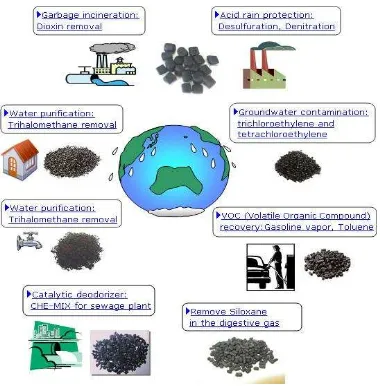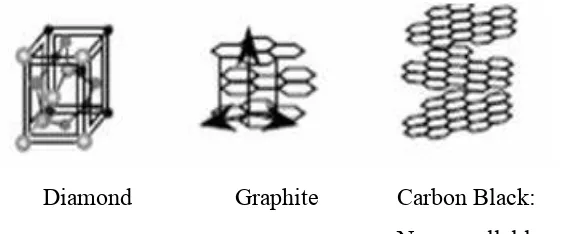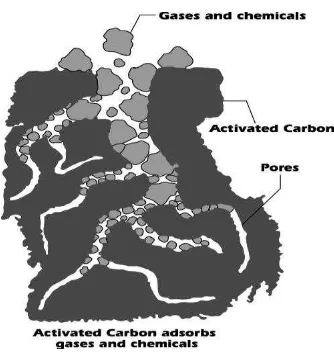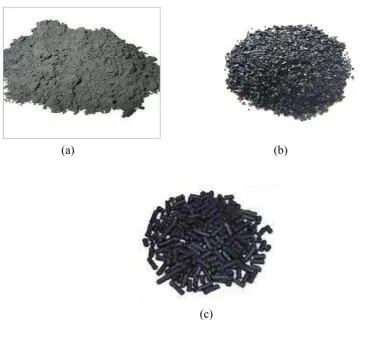SYNTHESIS OF ACTIVATED CARBON FROM WASTE RAW MATERIAL USING “BULUH LEMANG‟‟, SCHIZOSTSCHYUM BRACHYCLADUM.
SHAFARUL BIN MUSTAFA
SUPERVISOR DECLARATION
“I hereby declare that I have read this thesis and in my opinion this report is sufficient in terms of scope and quality for the award of the degree of
Bachelor of Mechanical Engineering (Structure and Materials)”
Signature : ...
Supervisor I : En. Imran Syakir bin Mohamad Date : ...
ii
SYNTHESIS OF ACTIVATED CARBON
FROM WASTE RAW MATERIAL USING “BULUH LEMANG’’,
SCHIZOSTSCHYUM BRACHYCLADUM.
SHAFARUL BIN MUSTAFA
This Report Is Submitted In Partial Fulfillment of Requirements For The Bachelor of Mechanical Engineering (Structure and Materials) with Honours.
Faculty of Mechanical Engineering Universiti Teknikal Malaysia Melaka
iii
DECLARATION
“I hereby declare that the work in this report is my own except for summaries and quotations which have been duly acknowledged.”
Signature : ………
Name of Candidate : SHAFARUL BIN MUSTAFA
iv
For my beloved mother,
v
ACKNOWLEGMENT
AssalamualaikumWarrahmatullah .
vi
ABSTRACT
The main objective of this work was to synthesis waste of bamboo as the activated carbon and characterized the activated carbon. The unique of activated carbon commonly known by the principle of adsorptivity which be applied in removing contaminants and odor in the water and air. This has been adopted in many industrial field associated with waste treatment to reduce pollution. The potential of activated carbon has been acknowledge in many publications to efficiently provide adsorption site for this purpose. Hence, in this particular study, the application of activated carbon manufactured from the waste of bamboo (Schizostachyum brachycladum) or better known as buluh lemang amongs the Malay community was investigated. The effect on process variables such as activating agents zinc chloride (ZnCl2) activation temperature, impregnation ratio and carbonization temperature
were studied to optimize these parameters. The resulting activated carbon were characterized in terms of iodine number (I2 number) for its adsorptive capacity ,
Scanning Electron Microscope (SEM) and Brunauer, Emmett, Teller (BET) method were used to provide information on surface area, pore size, types of pore (micropores, mesopores, macropores) and total pore volumes. Result iodine number shows, sample activated carbon, chemical activation(temperature 500ºC, impregnation ratio 1:1) has higher value which is 295 mg/g among others samples. In BET analysis, sample activated carbon, physical activation (500ºC) shows good surface area, 339.1 m2/g and total volume pore, 1.042 cc/g. Lastly, for SEM-EDX
vii
ABSTRAK
Objektif utama projek ini adalah untuk mensintesis sisa buangan daripada buluh lemang untuk menjadi karbon teraktif dan seterusnya menganalisa sifat-sifat karbon teraktif tersebut. Keunikan karbon teraktif umumnya diketahui berdasarkan prinsip jerapan yang dapat diaplikasikan bagi menghilangkan kotoran dan bau dalam air dan udara. Karbon teraktif telah diterima pakai di dalam pelbagai bidang industri yang berkaitan dengan pengurusan sisa bagi mengurangkan pencemaran. Potensi karbon teraktif telah diakui melalui pelbagai penerbitan sebelum ini dalam menyediakan kajian jerapan secara cekap. Oleh itu, dalam kajian yang dijalankan, aplikasi karbon teraktif dihasilkan dari sisa buangan daripada buluh (Brachycladum Schizostachyum) atau lebih dikenali sebagai 'buluh lemang' dalam komuniti Melayu. Selain itu, kajian ini mengkaji karbon teraktif apabila pembolehubah yang digunakan di dalam pembuatan karbon teraktif seperti agen pengaktifan yang digunakan, zink klorida (ZnCl2), suhu pengaktifan, nisbah impregnasi dan suhu
karbonisasi bagi mengoptimumkan penghasilan karbon teraktif tersebut. Karbon teraktif yang dihasilkan dikenalpastikan sifatnya dengan menggunakan analisis nombor iodin (nombor I2) untuk memperoleh daya serap, selain itu, Mikroskop
Imbasan Elektron (SEM) dan kaedah Brunauer, Emmett, Teller (BET) digunakan untuk memperolehi maklumat mengenai luas permukaan, saiz liang, jenis liang (liang mikro, liang meso, liang makro) dan jumlah liang yang terdapat pada karbon teraktif yang dihasilkan. Keputusan nombor iodine menunjukkan sampel karbon teraktif daripada pengaktifan kimia (suhu 500ºC , nisbah impregnasi 1:1) mempunyai nilai yang paling tiggi daripada sampel karbon teraktif yang lain dengan nilai 295 mg/g. Dalam analisis BET, sampel pengaktifan fizikal (500ºC) mempunyai keluasan permukaan yang baik 339.1 m2/g dan jumlah isipadu liang, 1.042 cc/g. Akhir sekali,
ix
2.3 Activated Carbon Manufacture. 11
2.3.1 Activation Method 12
2.3.2 Activating Agents 13
2.3.3 The methods of activating agents mixing 13 2.4 Raw material for activated carbon 14 2.4.1 The selection of raw material. 16 2.5 Bamboo Waste
2.5.1 Bamboo. 17
2.5.2 General Applications 19
2.5.3 Chemical Composition 20
2.6 Standard for activated carbon 22 2.6.1 Characteristics of activated carbon 22
2.7 Characterization Method. 24
2.7.1 Iodine number analysis 24
2.7.2 Brunauer–Emmett–Teller (BET) 32 2.7.3 Scanning Electron Microscopy (SEM) 33
CHAPTER III METHODOLOGY
3.1 Introduction 36
3.2 Experimental Procedure 38
3.2.1 Procedure of chemical activation. 38 3.2.2 Procedure of physical activation. 39 3.2.3 Procedure Iodine number analysis 39 3.2.4 Procedure Nitrogen adsorption analysis 40 3.2.5 Procedure EDX-SEM analysis 40
CHAPTER IV RESULT AND ANALYSIS 41
CHAPTER V DISCUSSION 59
CHAPTER VI CONCLUSION 61
REFERENCES 62
x
LIST OF FIGURES
FIGURE
TITLE PAGEFigure 2.1 Application of activated carbon. 6
Figure 2.2 Carbon Black “Quasi-Graphitic” Microstructure 8 Compared to the two regular crystalline
forms of Carbon (Diamond And Graphite).
Figure 2.3 Activated carbon adsorption for gases and chemicals. 9
Figure 2.4 Types of activated carbon. 10
Figure 2.5 Bamboo forestry 19
Figure 2.6 Bamboo (Schizostachyum brachycladum) and lemang 20 Figure 2.7 One of Brunauer, Emmet And Teller (BET) Machine. 33 Figure 2.8 The basic premise of an SEM is that signal produced 35
from a scanned area of the specimen is displayed as an image with the exact same scan pattern on a CRT.
Figure 2.9 SEM Photograph of Commercial Activated Carbon (AC). 35
xi
LIST OF TABLES
TABLE TITLE PAGE
Table 2.1 Commercially available carbons. 10
Table 2.2 Characteristic of commercial raw 16
material as activated carbon .
Table 4.1 Sample activated carbon with chemical activation, 42 (500ºC, impregnation ratio, 1:1)
Table 4.2 Sample activated carbon with chemical activation, 42 (500ºC, impregnation ratio, 1:2)
Table 4.3 Sample activated carbon with chemical activation, 42 (600ºC, impregnation ratio, 1:1)
Table 4.4 Sample activated carbon with chemical activation, 43 (600ºC, impregnation ratio, 1:2)
Table 4.5 Sample activated carbon with physical activation, 43 (Temperatures, 500ºC)
Table 4.6 Sample activated carbon with physical activation, 43 (Temperatures, 600ºC)
Table 4.7 Sample activated carbon, commercial 44
Table 4.8 Result Iodine number analysis 53
Table 4.9 BET Analysis Data 54
Table 4.10 SEM- EDX (percentage of atomic element) (%) 55
xii
N number of adsorbed molecular layers n dependence of the amount of adsorption
ε adsorption potential
K Kelvin
ºC degree Celsius
η electron coefficient
δ secondary electron coefficient H3PO4 phosphoric acid
KOH potassium hydroxide
xiii
LIST OF ABBREVIATION
ASTM American Society for Testing Material
AWWA American Water Works Association.
BET Brunauer–Emmett–Teller
SEM Scanning Electron Microscope
IUPAC International Union of Pure and Applied Chemistry.
AC Activated Carbon
GAC Granular Activated Carbon
PAC Powder Activated Carbon
CRT Cathode Ray Tube
BC Before century
1 festive seasons in Malaysia. Thus, one of the solutions for water or air pollution is to use the ability of activated carbon (AC) to filter the chemical associated with the waste. Currently, the bamboo culm, or stem, has been made into an extended diversity of products ranging from domestic household products to industrial applications (McClure ,1967). Examples of bamboo products are food containers, skewers, chopsticks, handicrafts, toys, furniture, flooring, pulp and paper, boats, charcoal, musical instruments and weapons. In Asia, bamboo is quite common for bridges, scaffolding and housing, but it is usually a temporary exterior structural material. In many overly populated regions of the tropics, certain bamboos supply the one suitable material that is sufficiently cheap and plentiful to meet the extensive need for economical housing.
2
According to Gadkaree (1998), activated carbon is a very important material industrially, with applications in a variety of areas such as adsorbers in air and water pollution control, catalysts in the chemical and petrochemical industries. Typically activated carbon is made from naturally occurring materials such as wood, coal and nutshell flour etc. via high temperature, inert atmosphere processing followed by activation to create porosity in the nanometer size range. This porosity imparts special adsorption characteristics to carbon and makes it useful in the variety of applications mentioned above.
1.1 OBJECTIVE
The main objective of this project is to synthesis * activated carbon (AC) from easily available raw material (bamboo). This is done by aiming on the specific objectives as follow:
1. To synthesis activated carbon from waste materials.( waste of bamboo)
2. To investigate the adsorption performance of activated carbon using iodine number analysis
3. To characterize the properties of activated carbon prepared using analytical spectroscopy.( SEM-EDX, N2 adsorption analysis)
1.2PROBLEM STATEMENT
3
1.3SCOPE
1. To find and prepared the waste of bamboo . Type of bamboo was selected is (Schizostachyum brachycladum) , among Malay call buluh lemang. Washed with water and dried the bamboo under normal sun light. The bamboo was cut into part about 10cm- 15cm and crush using industry crusher (3-4 mm) to make its easier during synthesis process.
2. This studied about activated carbon had been carried out only on laboratory scale. It is started from synthesis waste of bamboo by activated manufacturing system carbonization and activation. Activation that used for synthesis raw material are Physical (Gas Carbon Reactor) and Chemical activation , use zinc chloride as activating agents (ZnCl2 )
3. Characterize activated carbon after finished the synthesis process and find properties of activated carbon by using a few method such as Scanning Electron Microscopy (SEM) to find structural properties and morphology of activated carbon . Others method used are Brunauer Emmet Teller Method (BET), N2 adsorption and Iodine Number, I2, analysis.
1.4 EXPECTED RESULT
4
CHAPTER TWO
LITERATURE REVIEW
2.1 HISTORY OF ACTIVATED CARBON
Activated carbon was first generated industrially at the first part of the 20th
century, when carbon activated from vegetable material was produced for use in sugar refining. Powered activated carbon was first produced commercially in Europe in the early 19th century, using wood as a raw material. This carbon found widespread use in the sugar industry. In the United States, the first production of activated carbon used black ash as the source, after it was accidentally discovered that the ash was very effective in decolorizing liquids. Activated carbon has since been used extensively for this purpose in many industries. In particular, it has been commonly used for the removal of organic dyes from textile wastewater. The first documented use of activated carbon in a large scale water treatment application was in 19th century England, where it was used to remove undesirable odors and tastes
5
2.2 ACTIVATED CARBON
Activated carbon is porosity (space) enclosed by carbon atoms. Activated carbon is a microcrystalline, nongraphitic form of carbon that has been processed to develop internal porosity. This porosity yield the surface area that provides ability to adsorb gases and vapors from gases and to adsorb dissolved or dispersed substances from liquid.activated carbon is characterized by a vast system of pore of molecular size within the carbon particles resulting in the formation of a material with extensive surface area. However, commercial grade of activated carbons generally have a surface areas ranging from 600 to 1200 m2/g.(Chilton Ng et al.2002)
Activated carbon is a very important material industrially, with applications in a variety of areas such as adsorbents in air and water pollution control, catalysts in the chemical and petrochemical industries. Electrodes in batteries and supercapacitors and also purifiers in the food and pharmaceutical industries. Further, as an environmental pollution is increasingly becoming a serious problem the demand for activated carbon is growing.( K.P Gadkaree.1998)
2.2.1 Properties of Activated carbon (AC): Solid, porous, black carbonaceous material
Extraordinary large surface area (1200m2/g) and pores volume that give unique
Complex action mode
6
Figure 2.1: Application of activated carbon. (Source: http://www.cataler.co.jp)
2.2.2 Structure of Activated carbon
7
A later idea was that the cross-links might consist of domains containing
sp3-bonded atoms, but this had to be discounted when neutron diffraction studies
showed that non-graphitizing carbons consist entirely of sp2 atoms .A much more
recent suggestion is that non-graphitizing carbon has a structure related to that of the
fullerenes, in other words that it consists of curved fragments containing pentagons
and other non-hexagonal rings in addition to hexagons. Such a structure would
explain the micro porosity of the carbon, and many of its other properties. However,
obtaining direct experimental support for this hypothesis is extraordinarily difficult.
Both x-ray and neutron diffraction have been extensively applied to non-graphitizing
carbons, and in some studies the diffraction data has been interpreted in terms of a
structure containing non-hexagonal rings (Peter J F Harris et al. .2008).
The IUPAC classification of pores by sizes defines the following three class
of pore (IUPAC .1972):
Micropores, less than 2 nm (less than 20 Å)
Mesopores between 2 and 50 nm, (20 to 500 Å)
Macropores, 50 nm, (more than 500 Å).
According to T. Otowa et al. (1997), Tsutomu Suzuki et al. (2007) and A.
Linares-Solano et al. (2000), usually more than 95% micropores content in the total
area surface of activated carbon. The volume of micropores range from 0.15 up to
0.6 cm3/g. Conventional activated carbon were tridisperse, having all three type of
pores present within their structure. Absorbance molecules penetrate through the
wider pore to micropores. Activated carbon prepared with high surface area, low
volume resistivity or low ash content has been reported largely. The composition and
structure of an activated carbon depends on the raw material, the activating agent and
the preparation method. These parameters condition the properties of the activated
8
Diamond Graphite Carbon Black:
Non-parallel layer planes Figure 2.2: Carbon Black “Quasi-Graphitic” Microstructure compared to the
Two Regular Crystalline Forms of Carbon (Diamond and Graphite).
2.2.3 Activated Carbon adsorption.
According to Khadija Qureshi et al. (2008), they are most effective adsorbents in treating drinking water and industrial wastewater. The food industry is also a major consumer of activated carbon, where it is used to remove compounds that adversely affect color, taste and odor. In the mineral industry activated carbon are used to recover gold from leached liquors. Medicinal uses and pharmaceutical industry is also another wide area for the utilization of activated carbon. In gas cleaning applications activated carbon are extensively used in air filters at industrial level as well as in general air conditioning application.
9
Figure 2.3: Cross sectionactivated carbon adsorption for gases and chemicals. Source: (home-air-purifier-guide.com)
2.2.4 Type and selection of activated carbon.
Refer to C. Srinivasakannan (2003), there are three different types of activated carbon. Based on the application a specific type of activated carbon is used: a. Powdered Activated Carbon (PAC) (particle size predominantly
smaller than 80 mesh) - used for taste and odor removal
b. Granular Activated Carbon (GAC) (particle size predominantly more than 80 mesh )- Used for liquid and gas phase application
10
Table 2.1: Commercially Available Carbons. Source: (William D.F. et al. 1987)



